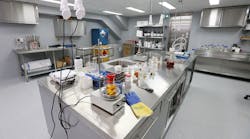The CAP-300 and CAP-100 from Gems Sensors & Controls are two sensors designed for distinctly different applications and target audiences. But they have at least one thing in common: The sensors fill a void in the marketplace, explains Charlie Sorbo of Plainville, Conn.-based Gems.
In the case of the CAP-300, the company saw a need "for a low-cost, reliable low-coolant sensor for radiators across power-generation equipment and off-highway vehicles as well as within trucks, trains and buses," Sorbo tells New Equipment Digest.
In the case of the CAP-100, "Gems increasingly saw customer applications where a non-contact, no-moving-part sensor was needed to monitor waste, reagents and diluent liquids where traditional sensors failed," says Sorbo, who is product sales manager, point-level and temperature sensors, for Gems.
NED: Why did Gems Sensors & Controls decide to market these products?
CS: With the CAP-300, we saw a void in the marketplace for a low-cost, reliable low-coolant sensor for radiators across power-generation equipment and off-highway vehicles as well as within trucks, trains and buses.
Regarding the CAP-100, as a leading provider of sensors to the medical industry, Gems increasingly saw customer applications where a non-contact, no-moving-part sensor was needed to monitor waste, reagents and diluent liquids where traditional sensors failed.
NED: How are these sensors different from similar products?
CS: The CAP-300 is a modular design that lends itself well to customization for OEM applications. It is prequalified and tested to very rigid off-highway vehicle standards. It uses a higher-level capacitance technology modification to help prevent false readings from coating often found in coolants in radiators. The 300 also is ideal for users as well, as it comes in 48 standard configurations ideal for all global customers and can be shipped in any of the 48 varieties in five days or less.
The CAP-100 is a truly unique solution for the market where it offers a non-contact capacitive solution that can be pre-calibrated for customer solutions or has the ability to be calibrated by the customer to meet applications for a wide variety of bottle types (glass, plastic and fiberglass). The sensor also has the ability to mount in a variety of ways for ease of use.
NED: What problems did you encounter during the development process?
CS: The CAP-300 took considerable time and effort to fine-tune the capacitance technology to be able to handle a broad range of coolants and to be able to perform across the most challenging environments. Many coolant sensors offered in the marketplace do not have this ability.
The CAP-100's biggest challenge was around sensitivity and developing a capacitive sensor that could give customers extremely accurate readings.
NED: How long did it take from conception to final production?
For the CAP-300, close to three years. For the CAP-100, close to two years.
NED: Did cost factors play a role in changing the final design of the product?
CS: No. Before Gems started the development of the CAP-300, we did exhaustive customer research to determine the market needs in terms of performance and pricing. Neither was compromised during our development.
NED: Who do you consider your target audience to be and what benefits will they achieve from using this product?
CS: For the CAP-300, any customer that uses 100 percent water coolant that is looking for a pre-qualify, cost-effective product for low-, intermediate- or high-liquid-level sensing, but our major focus was radiators on generators and off-highway vehicles.
For the CAP-100, our target audience is within medical laboratory equipment for waste tanks, wash detergents, reagents and diluents. Another target application is for the monitoring of the level of print ink. The sensor is perfect for any solution where customers need a non-contact, no-moving-part solution for challenging fluids.
Latest from Research and Development
Latest from Research and Development










